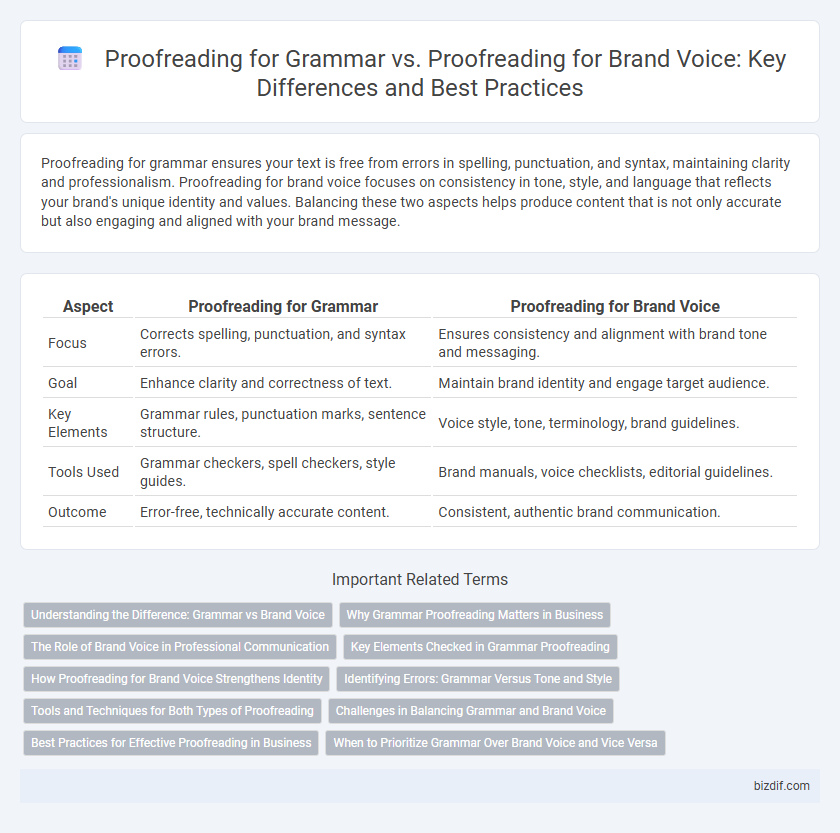Proofreading for grammar ensures your text is free from errors in spelling, punctuation, and syntax, maintaining clarity and professionalism. Proofreading for brand voice focuses on consistency in tone, style, and language that reflects your brand's unique identity and values. Balancing these two aspects helps produce content that is not only accurate but also engaging and aligned with your brand message.
Table of Comparison
| Aspect | Proofreading for Grammar | Proofreading for Brand Voice |
|---|---|---|
| Focus | Corrects spelling, punctuation, and syntax errors. | Ensures consistency and alignment with brand tone and messaging. |
| Goal | Enhance clarity and correctness of text. | Maintain brand identity and engage target audience. |
| Key Elements | Grammar rules, punctuation marks, sentence structure. | Voice style, tone, terminology, brand guidelines. |
| Tools Used | Grammar checkers, spell checkers, style guides. | Brand manuals, voice checklists, editorial guidelines. |
| Outcome | Error-free, technically accurate content. | Consistent, authentic brand communication. |
Understanding the Difference: Grammar vs Brand Voice
Proofreading for grammar involves identifying and correcting errors related to syntax, punctuation, and spelling to ensure clarity and professionalism. Proofreading for brand voice focuses on maintaining the consistent tone, style, and personality that align with a brand's identity across all content. Understanding this difference is crucial for producing polished materials that are both linguistically accurate and authentically representative of the brand's message.
Why Grammar Proofreading Matters in Business
Grammar proofreading ensures clear communication, preventing misunderstandings that can damage a business's credibility and customer trust. Proper grammar enhances professionalism and reflects attention to detail, essential for maintaining a strong brand reputation. Consistent grammatical accuracy supports effective marketing, legal compliance, and overall brand integrity in competitive markets.
The Role of Brand Voice in Professional Communication
Proofreading for brand voice ensures consistency in tone, style, and personality across all professional communications, reinforcing a company's identity and fostering trust with the audience. Unlike grammar-focused proofreading that targets syntax, punctuation, and spelling, brand voice proofreading preserves the unique linguistic attributes that differentiate a brand. Maintaining a clear and authentic brand voice strengthens engagement, supports marketing efforts, and enhances overall credibility in professional interactions.
Key Elements Checked in Grammar Proofreading
Grammar proofreading primarily focuses on key elements such as syntax accuracy, punctuation consistency, and correct verb tense usage to ensure clarity and professionalism. It also involves checking subject-verb agreement, proper sentence structure, and the elimination of spelling errors. These foundational linguistic components guarantee that the text is free from grammatical mistakes, enhancing readability and credibility.
How Proofreading for Brand Voice Strengthens Identity
Proofreading for brand voice ensures consistency in tone, language, and style, reinforcing a company's unique identity across all communications. Unlike grammar proofreading that focuses on correctness and clarity, brand voice proofreading aligns messaging with the brand's core values and personality. This targeted approach strengthens customer recognition and trust by maintaining a coherent and distinctive brand presence.
Identifying Errors: Grammar Versus Tone and Style
Proofreading for grammar involves meticulously identifying and correcting syntax, punctuation, and spelling errors to ensure linguistic accuracy and clarity. In contrast, proofreading for brand voice requires evaluating tone consistency, style alignment, and vocabulary choice to maintain the brand's unique identity across all content. Both approaches are essential for producing polished text that resonates with target audiences while adhering to professional standards.
Tools and Techniques for Both Types of Proofreading
Proofreading for grammar primarily relies on advanced grammar checking tools like Grammarly and Hemingway Editor, which identify syntax errors and punctuation mistakes with precision. In contrast, proofreading for brand voice emphasizes AI-driven style guides and custom lexicons to ensure consistency in tone, terminology, and messaging aligned with brand identity. Combining human review with software such as ProWritingAid enhances accuracy by addressing both technical correctness and brand-specific nuances effectively.
Challenges in Balancing Grammar and Brand Voice
Proofreading for grammar requires strict adherence to language rules, ensuring clarity and correctness, while proofreading for brand voice demands maintaining a consistent tone and personality that aligns with the brand's identity. The challenge lies in correcting grammatical errors without diluting the unique style or risking the brand's distinct voice becoming generic or overly formal. Effective proofreading balances precise language standards with the nuanced expression of brand characteristics to enhance engagement and authenticity.
Best Practices for Effective Proofreading in Business
Proofreading for grammar ensures the accuracy of language by identifying and correcting errors in syntax, punctuation, and spelling, which maintains professionalism and clarity in business communication. Proofreading for brand voice requires aligning text with the company's tone, style, and messaging guidelines to reinforce brand identity and resonate with the target audience. Effective proofreading in business combines meticulous grammatical review with consistent brand voice adherence, leveraging style guides and collaborative reviews to uphold quality and strengthen customer trust.
When to Prioritize Grammar Over Brand Voice and Vice Versa
Prioritize grammar proofreading when clarity, professionalism, or legal accuracy is critical, such as in contracts, academic papers, and formal communications. Focus on brand voice proofreading when maintaining consistent tone, personality, and emotional resonance with the target audience is essential, especially in marketing materials, social media posts, and customer communications. Balancing grammar and brand voice depends on the purpose and context of the content, ensuring both accuracy and brand integrity are preserved.
Proofreading for Grammar vs Proofreading for Brand Voice Infographic

 bizdif.com
bizdif.com